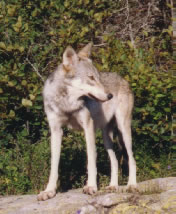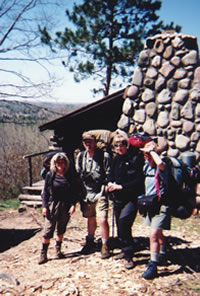Our four-day backpack through the Green
Timbers Wilderness Tract and the Pigeon River State Forest
was a trip of relaxation and renewal as well as a rehearsal
for future wilderness tripping challenges. The participants
were Gail Staisil of Midland, Jane Beckwith of Lansing, Kevin
Breen of Grand Rapids, myself, and Michael Neiger of Marquette.
The area around Green Timbers does not
permit any visual boredom. We began the hike in a cleared
area crowded with young aspens competing for sunshine. This
blended into open meadows on low rolling hills, dotted with
the burned out stumps of the original forest giants. We scanned
these for elk. 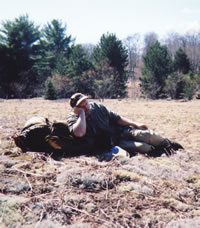
Kevin Breen of Grand Rapids
takes a well-deserved break
while passing through the
Green Timbers Wilderness Tract.
(Photo by Mary Powell)
View Gail Staisil's
Photo
Album from this trip
Low land by streams had alder thickets,
stands of pine, and tangles of cedar. There were high ridges,
some open, some covered by mixed or hardwood forest.
There were streams in assorted sizes: Club
Creek and the Sturgeon and Pigeon Rivers. We viewed them from
ridge tops twisting below us, sparkling in the sun beneath
the pale green haze of new foliage on the trees.
We found them winding through swamps with
cedars bending over them from both sides to make a deep green
tunnel. We drank their clear cold water. We crossed them on
bridges and waded through them where there were none.
We saw the effect of a dam on a stream:
Cornwall Flooding, a sizeable placid lake with numerous offshore
stumps and snags and much evidence of beaver activity--though
the dam itself was manmade.
And finally, we saw a number of sinkhole
lakes: deep round or nearly round depressions filled with
cerulean blue water and edged with white sand and the bleached
trunks of fallen trees. Gail's post trip research determined
that these came into being when underground caves collapsed
and filled with water. These caves were created by the erosion
of relatively soft layers of limestone by underground streams.
Areas where sinkholes occur are called
karst regions and often contain unique ecosystems that are
very sensitive to outside influences because of their isolated
nature. The sinkholes we saw were posted to prohibit camping
and fishing for that reason.
Friday evening we camped atop an open hill
that gave us an impressive view of a wetland and of the meadowland
surrounding it. More opportunity to scan for the elusive elk.
The wetland provided the water at this
campsite. It was the color of iced tea and contained enough
mosquito nymphs to meet a person's protein requirement for
the day. Tasted better than city water though.
Some of us had bivouacked here in early
April the year before. Sleeping out on the hill on that trip
we were aroused by 40 mile an hour winds and the need to take
down our tarps, which were flapping wildly like sheets on
a clothesline. Some of us elected to sleep out there again
and this time all was quiet.
Turning over in the night I would fall
back asleep marveling at the intensely starry sky-- so different
from what is visible in town. I awoke for the day just a little
after dawn to chilly feet and a world sparkling with frost.
Saturday we hiked some extra miles to reach
another spot at which we'd camped before--an island in the
Pigeon River covered with huge cedars and surrounded by the
sounds of flowing water. Hard to say whether it was the cushy
bed of cedar duff, the soothing water sounds, or the fact
that it was warmer, but I slept very well there! Gail liked
this spot too, describing it as a "pristine pine forest
camp...with so much tranquility."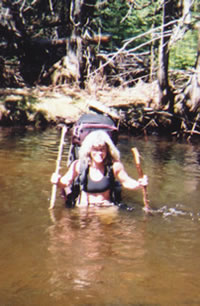
Jane Beckwith of East Lansing
fords the deep waters of
the Pigeon River.
(Photo by Mary Powell)
View Gail Staisil's
Photo
Album from this trip
Sunday night was a new bivouac on the shore
of Cornwall Flooding. Not as choice as the other two, it was
still more than satisfactory. It afforded a view of the lake
populated by turtles, muskrats, and waterbirds that unknowingly
provided much of our evening's entertainment.
Kevin said the varied campsites were one
of his favorite parts of the trip. He liked their "remote,
hidden, and interesting" nature.
Each trip is a chance to catch up on the
intervening events in friends' lives and/or to get to know
someone new.
Jane told a very entertaining story of
her recent experience with llama packing--complete with amusing
imitations of the animals' mannerisms and accounts of their
occasional "attitude problems."
Kevin seemed to be an inexhaustible source
of information about flora and fauna--those we observed and
what he had seen on other trips and in nature centers.
Michael's dialog pertained mostly to wilderness
skills and upcoming trips. We were entertained by his plans
for Puskaskwa--hope the reality will be as enjoyable!
After the trip, Gail said, "The enthusiasm
that Michael displayed when his pack floated made me realize
that our next trip will have more interesting challenges."
May is a particularly pretty time of year:
everything is moist and green or becoming green.
The trout lilies had finished blooming
and trilliums were just getting started--we saw large flowered
and snowy varieties. There were patches of violets and the
lavender trimmed blooms of hepatica.
Flowering shrubs and trees--dogwood, cherry,
and others--were scattered throughout the woods, their pink
and white blossoms standing out against the pale greens of
new leaves.
Kevin had his binoculars out often in search
of warblers, thrushes, and such. We saw a number of woodpeckers--they
call attention to themselves with their insistent drumming--and
we heard woodcocks and grouse conducting their mating rituals
at dusk and dawn.
There were quite a few mallards hanging
around the ponds and streams. Gail and Kevin spotted some
mergansers and a loon on Cornwall Flooding.
One day at lunch we were visited by a bug
that looked like a cross between a small bee and a giant mosquito.
It had large dark eyes that looked like sunglasses. It hovered
motionless for a second or two before landing on my sleeve
as if to say, "What are you looking at? You look pretty
improbable yourself, you know." It made me chuckle.
Post trip investigation disclosed that
this visitor was probably a large bee fly, an insect that
subsists on nectar as an adult but parasitizes the nests of
solitary bees in its larval stage.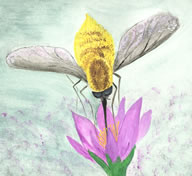
A large bee fly.
(Watercolor by Mary Powell)
View Gail Staisil's
Photo
Album from this trip
Each trip is an opportunity to try new
things and improve your system. Michael brought a recently
purchased hammock to experiment with. Trying it out at the
trailhead the night before the hike, he decided it needed
some retro work and did not bring it along. He also had a
retroed pack which despite its unusual shape, like a military
ALICE pack, seemed to carry well and pack easily.
Working on becoming an "ultralight"
hiker, I also had a new pack and was getting adjusted to its
differences--it was working pretty well once I got it organized.
My new boots were another story: I thought I had broken them
in sufficiently, but by day two my feet refused to be put
back in them and I finished the hike in sandals.
Thinking of switching from tent to tarp
but unsure of her ability to make a shelter from a flat piece
of cloth, Jane brought the next lightest thing-- a poleless
hexagonal teepee made by Golite. She and Michael experimented
each evening with different ways of suspending it.
Jane also watched to see what Gail, Michael,
and I did with our tarps. Of this trip she said, "I had
a lot I wanted and needed to learn on this trip. Learn I did!.....
Next time I know I can spend more time watching the sunset
and less time preparing the roof over my head."
Another goal on this trip was to practice
stream fording (we did plenty of that) and to see how a waterproofed
pack behaves in the water so as to know what to expect in
a real deep water crossing. At one stream Michael wrapped
his pack and floated it across. It was surprisingly buoyant
and not too difficult to handle.
As always, we practiced with map and compass,
Michael being in the teaching role and the rest of us soaking
up whatever we could.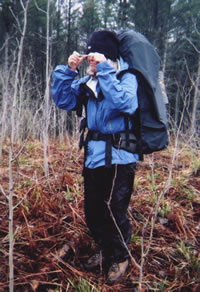
Jane Beckwith of East Lansing
cuts an azimuth with
her prism-sighting orienteering
compass as she leads the group
through the bush.
(Photo by Mary Powell)
View Gail Staisil's
Photo
Album from this trip
With the beautiful weather, few insects,
and excellent company, this trip was easy and fun. If it had
any deficit, it was that it ended too soon.
Read
another journal...
Return
to top of page | Return
to home page
In
God's wilderness lies the hope of the world,
the
great, fresh, unblighted, unredeemed wilderness.
—
John Muir 1838-1914, Alaska Wilderness, 1890
Content
Copyright © by Michael A. Neiger
All rights
reserved.
Comments?
Suggestions? Dead links? Inaccurate info?
Contact the
WebMaster at mneiger@hotmail.com
A
MacroMedia DreamWeaver 4 and Fireworks 4 production
|
